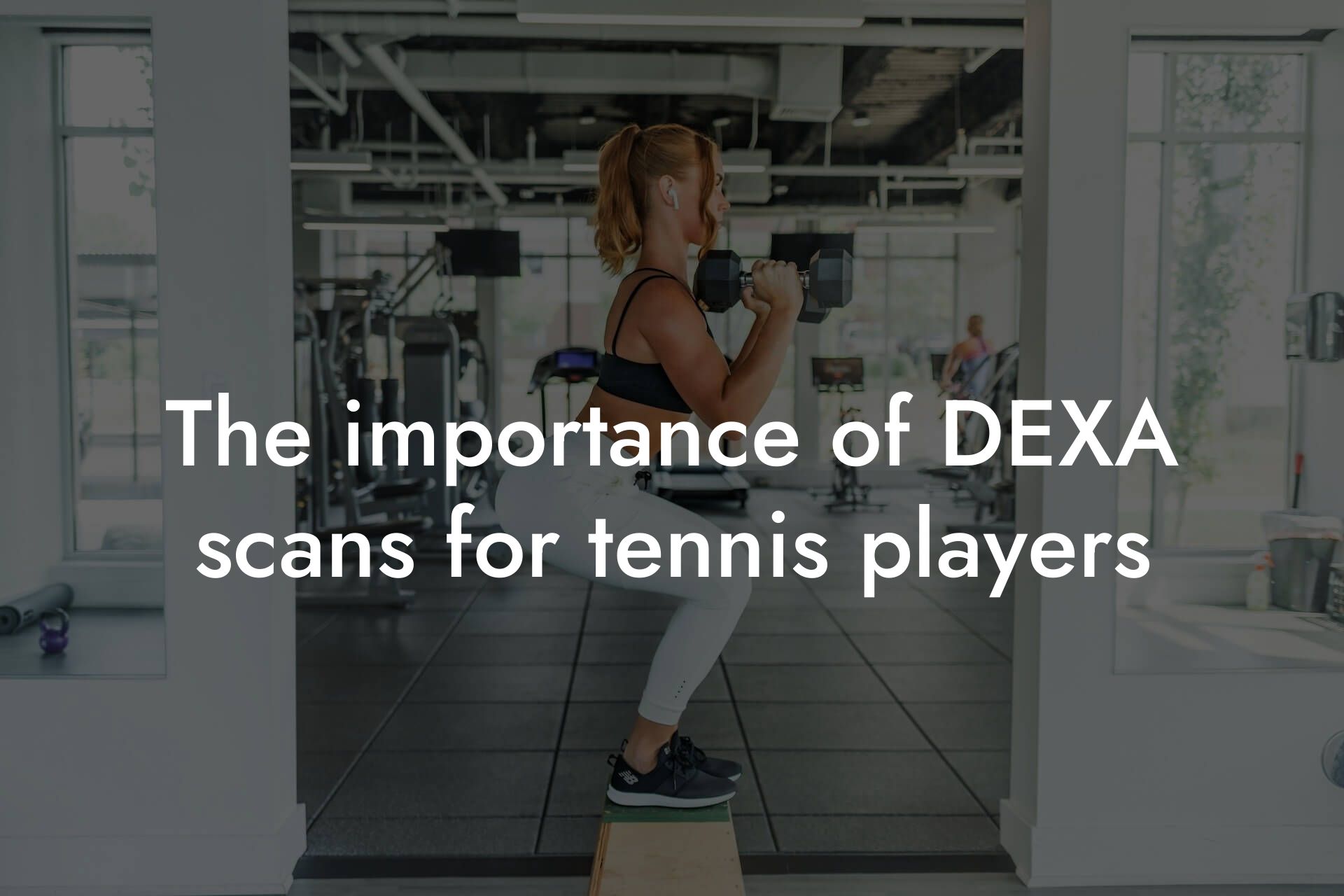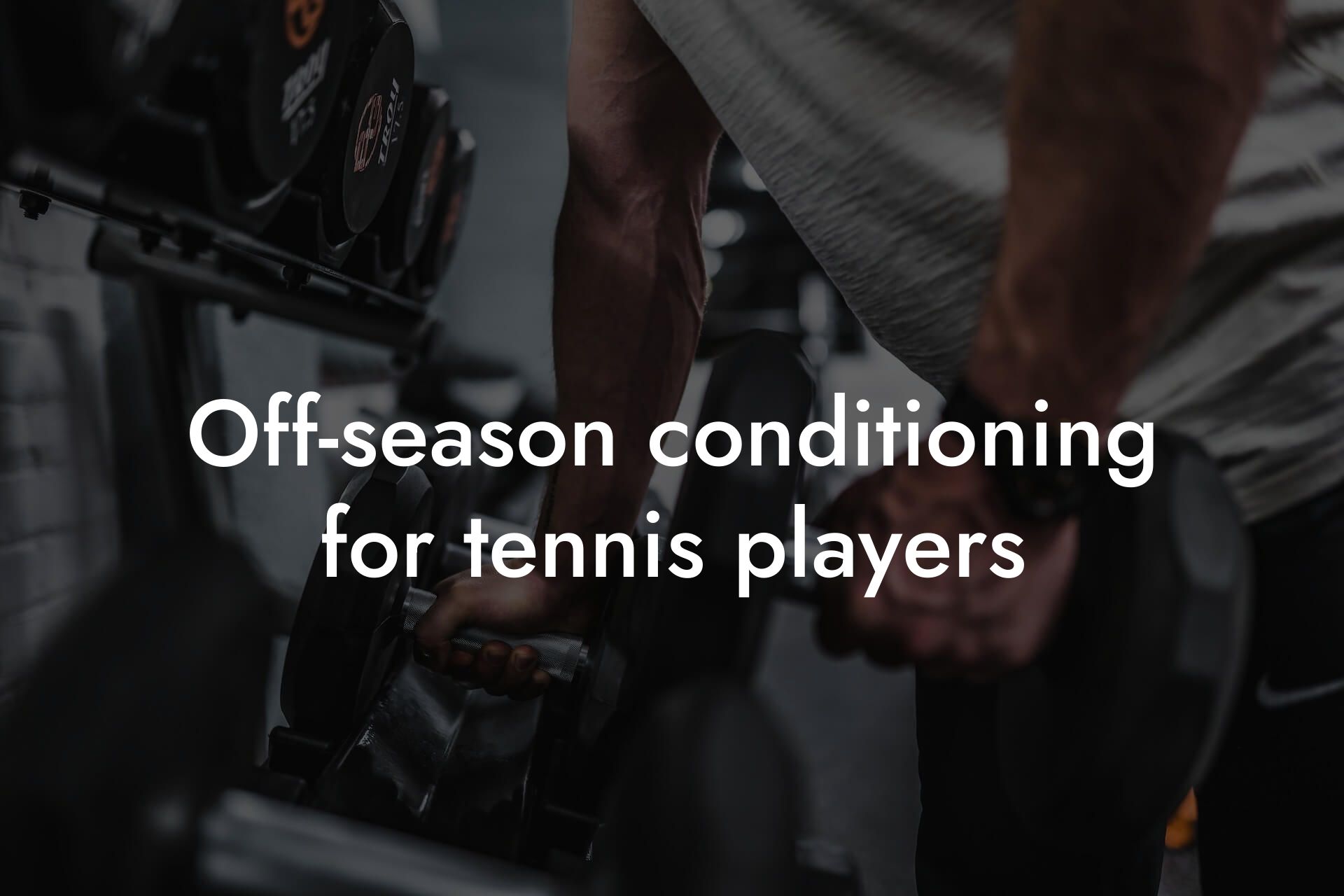As a high-earning professional, you understand the importance of maintaining a healthy physique to perform at your best on the tennis court. Long tennis matches can be grueling, both physically and mentally, and require a combination of skill, strategy, and endurance. At Tano Performance Group, we're committed to helping you optimize your body for peak performance. In this article, we'll provide you with a comprehensive guide on how to maintain endurance during long tennis matches.
Table of Contents
Understanding the Demands of Tennis
Tennis is a high-intensity sport that requires quick bursts of energy, rapid movements, and sustained periods of activity. A typical tennis match can last anywhere from 1-3 hours, with players covering distances of up to 5-7 kilometers during a single match. The physical demands of tennis are immense, with players requiring a combination of strength, power, speed, agility, and endurance to succeed.
Building Endurance Through Cardiovascular Training
Cardiovascular training is essential for building endurance and improving overall fitness. As a tennis player, you should aim to incorporate a mix of aerobic and anaerobic exercises into your training regimen. Aerobic exercises, such as jogging or cycling, help improve your body's ability to utilize oxygen and increase your endurance. Anaerobic exercises, such as sprinting or weightlifting, help improve your body's ability to generate power and speed.
Some effective cardiovascular exercises for tennis players include:
- High-Intensity Interval Training (HIIT): involves short bursts of high-intensity exercise followed by brief periods of rest.
- Endurance Training: involves sustained periods of moderate-intensity exercise to improve cardiovascular fitness.
- Strength Training: involves weightlifting or resistance exercises to improve muscular strength and power.
Nutrition and Hydration for Optimal Performance
Proper nutrition and hydration are critical for maintaining endurance during long tennis matches. A well-balanced diet that includes complex carbohydrates, lean protein, and healthy fats can help provide sustained energy and support muscle function. Additionally, staying hydrated by drinking plenty of water or sports drinks can help regulate body temperature, transport nutrients, and remove waste products.
Some effective nutrition and hydration strategies for tennis players include:
- Carbohydrate Loading: involves consuming high amounts of complex carbohydrates in the days leading up to a match to maximize glycogen stores.
- Electrolyte Balance: involves consuming electrolyte-rich foods or drinks to maintain proper electrolyte balance and prevent dehydration.
- Hydration Protocols: involves drinking specific amounts of water or sports drinks at regular intervals to stay hydrated during a match.
Mental Toughness and Focus
Mental toughness and focus are essential for maintaining endurance during long tennis matches. Tennis is as much a mental game as it is physical, and players who can stay focused and composed under pressure tend to perform better. Techniques such as visualization, positive self-talk, and mindfulness can help improve mental toughness and reduce stress and anxiety.
Some effective mental training strategies for tennis players include:
- Visualization: involves mentally rehearsing a match or specific scenarios to build confidence and focus.
- Positive Self-Talk: involves using positive affirmations to build confidence and reduce self-doubt.
- Mindfulness: involves being present in the moment and focusing on the task at hand to reduce stress and anxiety.
Recovery and Injury Prevention
Recovery and injury prevention are critical for maintaining endurance during long tennis matches. Adequate recovery time allows your body to repair and adapt to the physical demands of tennis, reducing the risk of injury and improving overall performance. Techniques such as stretching, foam rolling, and self-myofascial release can help improve flexibility and reduce muscle soreness.
Some effective recovery and injury prevention strategies for tennis players include:
- Active Recovery: involves engaging in low-intensity aerobic exercise, such as jogging or cycling, to promote blood flow and reduce muscle soreness.
- Stretching and Foam Rolling: involves using stretching exercises and foam rolling to improve flexibility and reduce muscle tension.
- Self-Myofascial Release: involves using tools such as lacrosse balls or tennis balls to release tension in the muscles and improve recovery.
Periodized Training for Optimal Performance
Periodized training involves varying the intensity and volume of training to optimize performance and reduce the risk of injury. By alternating between periods of high-intensity training and periods of low-intensity training, tennis players can improve their endurance, strength, and power while reducing the risk of overtraining and burnout.
Some effective periodized training strategies for tennis players include:
- Macro-Cycles: involves dividing the training year into distinct periods, such as pre-season, in-season, and off-season, to optimize performance and reduce the risk of injury.
- Micro-Cycles: involves dividing the training week into distinct periods, such as high-intensity training days and low-intensity recovery days, to optimize performance and reduce the risk of injury.
Using DEXA Scans to Optimize Performance
DEXA scans are a valuable tool for tennis players looking to optimize their performance and maintain endurance during long tennis matches. By providing detailed information on body composition, bone density, and muscle mass, DEXA scans can help tennis players identify areas for improvement and develop targeted training programs to optimize their physique.
At Tano Performance Group, we use DEXA scans to provide our clients with a comprehensive body assessment, helping them to:
- Identify areas of fat loss and muscle gain to optimize body composition.
- Develop targeted training programs to improve bone density and reduce the risk of injury.
- Monitor progress and adjust training programs to optimize performance.
Maintaining endurance during long tennis matches requires a combination of cardiovascular training, proper nutrition and hydration, mental toughness, recovery and injury prevention, periodized training, and the use of DEXA scans to optimize performance. By incorporating these strategies into your training regimen, you can improve your overall fitness, reduce the risk of injury, and perform at your best on the tennis court. At Tano Performance Group, we're committed to helping you achieve your goals and take your performance to the next level.
Frequently Asked Questions
What is endurance in tennis, and why is it important?
Endurance in tennis refers to the ability to sustain a high level of intensity over an extended period. It's essential in tennis because matches can last for hours, and players need to be able to maintain their energy levels to perform at their best. Good endurance enables players to recover quickly between points, maintain their focus, and execute their shots effectively.
How do I know if I need to improve my endurance for tennis?
If you find yourself getting tired easily during matches, struggling to recover between points, or experiencing a decline in your performance as the match progresses, it may be a sign that you need to work on your endurance. Additionally, if you're experiencing muscle cramps, dizziness, or nausea during or after playing, it could be an indication that your endurance needs improvement.
What are the key components of endurance in tennis?
There are three main components of endurance in tennis: cardiovascular endurance, muscular endurance, and mental endurance. Cardiovascular endurance refers to the heart's ability to pump blood efficiently, muscular endurance refers to the muscles' ability to sustain activity over time, and mental endurance refers to the ability to focus and stay motivated despite physical fatigue.
How can I improve my cardiovascular endurance for tennis?
To improve your cardiovascular endurance, engage in aerobic exercises such as jogging, cycling, or swimming for at least 30 minutes, three to four times a week. You can also incorporate high-intensity interval training (HIIT) into your workout routine, which involves short bursts of intense exercise followed by brief periods of rest.
What are some exercises to improve muscular endurance for tennis?
Exercises that target the legs, core, and upper body are essential for improving muscular endurance in tennis. Examples include squats, lunges, deadlifts, planks, and rows. You can also incorporate plyometric exercises such as jump squats and box jumps to improve your power and explosiveness.
How can I improve my mental endurance for tennis?
To improve your mental endurance, practice visualization techniques, such as imagining yourself playing a successful match or overcoming challenging situations. You can also work on your self-talk, focusing on positive affirmations to boost your confidence and motivation. Additionally, engage in mindfulness exercises to improve your ability to stay present and focused during competition.
What is the importance of hydration in maintaining endurance during long tennis matches?
Hydration is crucial in maintaining endurance during long tennis matches. Dehydration can lead to fatigue, cramping, and decreased performance. Aim to drink at least 8-10 glasses of water per day, and make sure to drink water or a sports drink during breaks in play to replenish lost electrolytes.
What role does nutrition play in maintaining endurance during long tennis matches?
Nutrition plays a vital role in maintaining endurance during long tennis matches. Focus on consuming complex carbohydrates, lean proteins, and healthy fats to provide sustained energy. Avoid sugary and processed foods that can cause energy crashes. Also, make sure to eat a balanced meal or snack 1-2 hours before playing to ensure you're fueled and ready to go.
How can I prevent muscle cramps during long tennis matches?
To prevent muscle cramps during long tennis matches, make sure to stay hydrated by drinking plenty of water and electrolyte-rich drinks. You can also take electrolyte supplements or consume foods high in electrolytes such as bananas, avocados, and nuts. Additionally, incorporate stretching and foam rolling into your warm-up and cool-down routines to reduce muscle tension.
What are some strategies for managing fatigue during long tennis matches?
To manage fatigue during long tennis matches, take regular breaks to rest and rehydrate. Use the time between points to stretch, move around, and get your heart rate back down. You can also try to conserve energy by playing more strategically, such as hitting shorter balls and taking advantage of your opponent's weaknesses.
How can I recover effectively after a long tennis match?
To recover effectively after a long tennis match, prioritize rest and recovery. Take a warm bath or shower to relax your muscles, and engage in gentle stretching or foam rolling to reduce muscle soreness. Also, consume a balanced meal or snack with a mix of carbohydrates and protein to replenish energy stores.
What are some common mistakes players make that can lead to endurance issues during long tennis matches?
Common mistakes players make that can lead to endurance issues during long tennis matches include inadequate preparation, poor nutrition, and inadequate hydration. Additionally, failing to pace oneself, not taking regular breaks, and neglecting to warm up and cool down properly can all contribute to endurance issues.
How can I incorporate endurance training into my tennis practice?
To incorporate endurance training into your tennis practice, try to simulate match conditions by playing longer sets or practicing with a higher intensity. You can also incorporate endurance exercises into your drills, such as running or jumping between shots. Additionally, work on your mental endurance by practicing visualization and self-talk techniques during practice.
What are some drills I can do to improve my endurance on the tennis court?
Drills such as " Suicide Drills" where you hit a shot and then sprint to the other side of the court, or "Endurance Ladder Drills" where you hit a shot and then run up and down the ladder, can help improve your endurance on the tennis court. You can also try "Pro Agility Shuttle Drills" which involve rapid changes of direction and speed.
How can I stay motivated to work on my endurance during the off-season?
To stay motivated to work on your endurance during the off-season, set specific and achievable goals for yourself, such as increasing your endurance by a certain amount or improving your performance in a specific area. You can also find a workout buddy or join a fitness group to provide accountability and support.
What are some common misconceptions about endurance in tennis?
Common misconceptions about endurance in tennis include the idea that endurance is only important for marathon matches, or that it's only necessary for professional players. However, endurance is essential for players of all levels, and it can make a significant difference in performance and overall health.
How can I measure my endurance progress in tennis?
To measure your endurance progress in tennis, track your performance metrics such as your heart rate, speed, and distance covered during matches. You can also use subjective measures such as how you feel during and after play, or your ability to recover quickly between points.
What are some endurance exercises that can be done off the tennis court?
Endurance exercises that can be done off the tennis court include running, cycling, swimming, and high-intensity interval training (HIIT). You can also incorporate strength training exercises such as squats, lunges, and deadlifts to improve your muscular endurance.
How can I incorporate strength training into my endurance training for tennis?
To incorporate strength training into your endurance training for tennis, focus on exercises that target your core, legs, and upper body. Incorporate exercises such as squats, lunges, deadlifts, and rows into your workout routine, and aim to do strength training exercises 2-3 times per week.
What are some mental endurance strategies that can be used during competition?
Mental endurance strategies that can be used during competition include visualization, positive self-talk, and mindfulness. You can also use breathing exercises and physical relaxation techniques such as progressive muscle relaxation to stay focused and calm under pressure.
How can I balance endurance training with technical training in tennis?
To balance endurance training with technical training in tennis, prioritize your goals and focus on one aspect at a time. For example, if you're working on improving your endurance, focus on endurance exercises during your workout, and then incorporate technical drills during your practice. Aim to allocate 20-30% of your practice time to endurance training, and 70-80% to technical training.
What are some common injuries associated with poor endurance in tennis?
Common injuries associated with poor endurance in tennis include muscle strains, tendonitis, and overuse injuries such as shin splints and plantar fasciitis. Additionally, poor endurance can increase the risk of heat-related illnesses such as heat exhaustion and heat stroke.
Here are some related articles you might love...
- Strength training programs for tennis athletes
- The importance of DEXA scans for tennis players
- Off-season conditioning for tennis players
- The role of bone density in preventing tennis injuries
- Improving core strength for better tennis strokes
- How body composition impacts tennis agility and speed
- Nutrition strategies for sustained energy during tennis matches
- Reducing body fat to enhance tennis performance
- Recovery techniques for tennis professionals
Zak Faulkner
Zak Faulkner is a leading authority in the realm of physical health and body composition analysis, with over 15 years of experience helping professionals optimise their fitness and well-being. As one the experts behind Tano Performance Group, Zak has dedicated his career to providing in-depth, science-backed insights that empower clients to elevate their physical performance and overall health.
With extensive knowledge of DEXA technology, Zak specializes in delivering comprehensive body assessments that offer precise data on body fat, muscle mass, bone density, and overall physique. His expertise enables individuals to make informed decisions and achieve their fitness goals with accuracy and confidence. Zak’s approach is rooted in a deep understanding of human physiology, combined with a passion for helping clients unlock their full potential through personalised strategies.
Over the years, Zak has earned a reputation for his commitment to excellence, precision, and client-focused service. His guidance is trusted by top professionals who demand the best when it comes to their health. Whether advising on fitness programs, nutritional strategies, or long-term wellness plans, Zak Faulkner’s insights are a valuable resource for anyone serious about taking their health and fitness to the next level.
At Tano Performance Group, Zak continues to lead our Content Team revolutionising how professionals approach their physical health, offering unparalleled expertise that drives real results.




